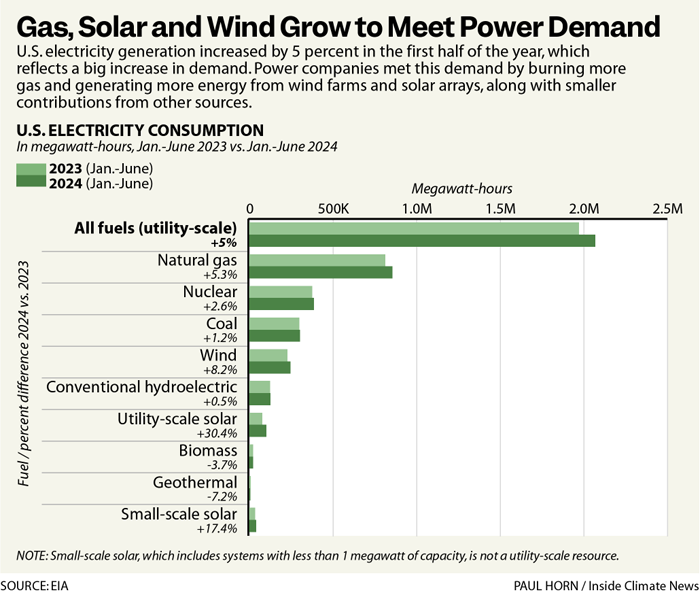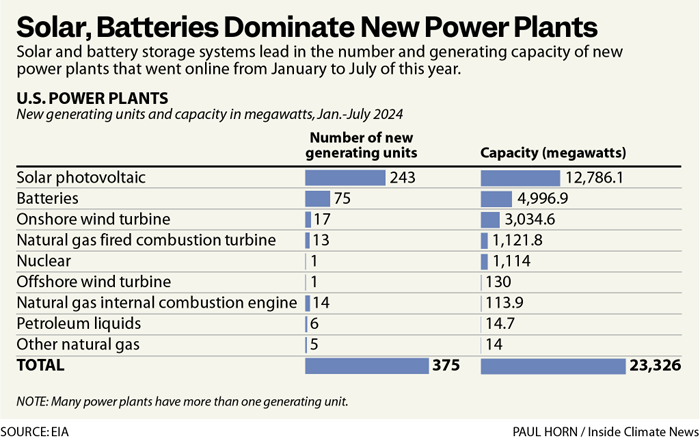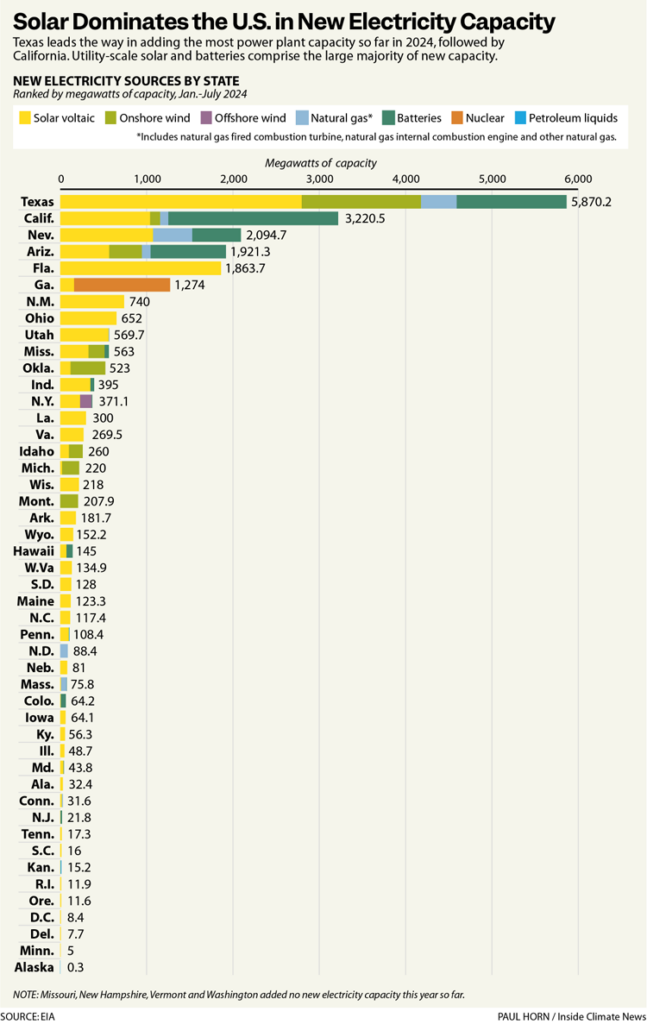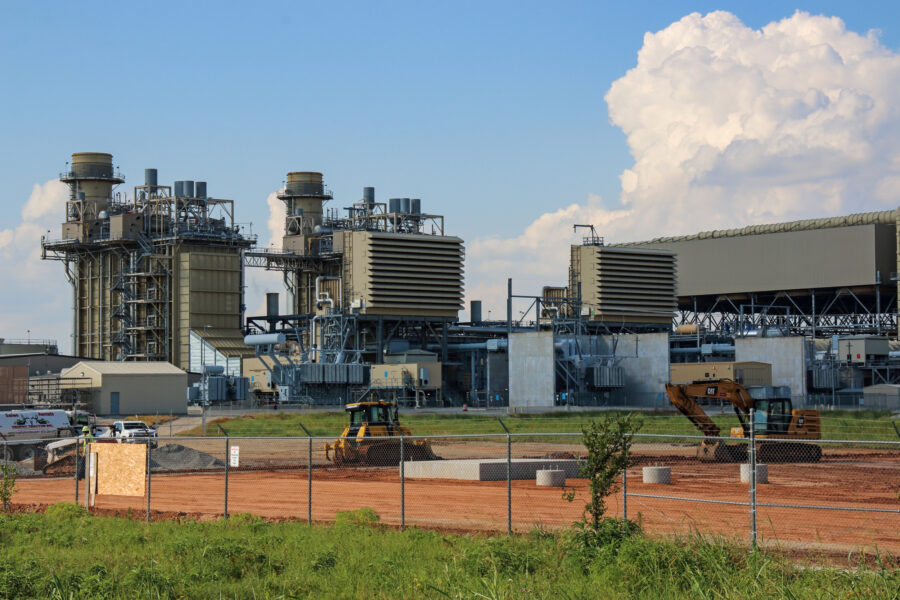The US Appetite for Electricity Grew Massively in the First Half of 2024, and Solar Power Rose to the Occasion
The United States increased its electricity generation from utility-scale solar power by nearly one-third in the first half of this year compared to the same period last year.
Despite that considerable increase in solar, the climate benefits of this growth were undermined by a rapid rise in electricity demand, which was met in large part by an increase in generation from fossil fuels.
This week, the Energy Information Administration released electricity generation statistics for June, which allows for a close look at where we stand halfway through 2024. The numbers tell a story of a country moving in the right direction, but not nearly fast enough.
Explore the latest news about what’s at stake for the climate during this election season.
First, the topline: Generation from utility-scale power plants was 2.1 million gigawatt-hours from January to June, an increase of 5 percent from January to June of 2023. That’s the highest percentage increase in decades when comparing the first half of a year to the first half of the prior year.
Grid planners and analysts have warned that the country is entering a period of rapid growth in electricity consumption to meet the needs of data centers, factories and other new construction. This follows a time of modest growth, which was due to a variety of factors, including the high efficiency of new lighting, appliances and building methods.
Heat, including the second-hottest June on record, is also a major factor when assessing energy consumption this year.
Rapid growth in electricity demand makes it harder for policymakers and energy companies to deal with climate change because it increases the size of the pool that new carbon-free electricity sources need to fill, and it hurts the economic case for shutting down fossil fuel power plants.

That said, generation from carbon-free power sources grew significantly in the first half of 2024.
Utility-scale solar plants generated 102,615 gigawatt-hours, an increase of 30 percent from the first half of 2023. Wind farms, both offshore and onshore, generated 247,434 gigawatt-hours, an increase of 8 percent.
Generation from fossil fuels also grew. Natural gas power plants—the country’s largest source of electricity by a wide margin—generated 857,023 gigawatt-hours, an increase of 5 percent. Coal-fired power plants generated 303,027 gigawatt-hours, an increase of 1 percent.
Put another way, gas and coal increased by a combined 46,843 gigawatt-hours, and wind and solar increased by a combined 42,698 gigawatt-hours.
That’s pretty depressing, so I’ll also note that the sum of increases in carbon-free sources, which includes nuclear, wind, solar and others, was 51,711 gigawatt-hours, and was more than the sum of the increases in gas and coal.
The larger point is that the growth in generation from carbon-free electricity sources needs to far outpace fossil sources by a lot, and it isn’t.
New Power Plants
So far this year, the country’s power companies are building vastly more renewable energy power plants than other types. Of the 375 new generating units that came online so far this year, 243 were utility-scale solar farms; 75 were utility-scale battery systems, which often work in tandem with renewable energy; 17 were onshore wind farms and 1 was an offshore wind farm, South Fork Wind off of New York. (Figures are from EIA’s power plant database, counting new generating units from January to July.)
During the same period, 38 natural gas or petroleum-burning units went online, and one new nuclear unit went online, at the Vogtle plant in Georgia. There were zero new coal plants.

The new units have 23,326 megawatts of capacity; 76 percent of this total comes from solar and batteries, and 95 percent comes from carbon-free sources (solar, batteries, onshore wind, offshore wind and nuclear).
Texas led the country in new construction, with a heavy emphasis on solar. California ranked second and was the leader in batteries.
This graphic from my colleague Paul Horn shows where new plants were built, which could be fodder for dozens of stories about what’s driving investment on a state-by-state basis.

The main caveat is that we’re talking about just seven months of new plants, and some states may have significant activity right before or right after this period.
It’s going to take some time for the new units to have much of an effect on national electricity generation statistics. Some of the new units are only a month or two old and not yet fully operational. Also, the list includes units completed in July, which would mean none of their output is included in the generation figures, which cover the first half the year.
I want to caution against exuberance about how much carbon-free resources are dominating new construction in this narrow timeframe.
To cut carbon emissions to a meaningful extent, it’s not enough for solar, wind and batteries to have a big lead in the number and capacity of new units. The lead needs to be gigantic and sustained over many years. And fossil electricity generation needs to fall, on a sustained basis, over many years.
Other stories about the energy transition to take note of this week:
General Motors and Samsung SDI Finalize Team-Up Plans in Indiana: General Motors and Samsung SDI said they have reached a final agreement on a joint venture announced last year to open a battery manufacturing plant near South Bend, Indiana, as Heekyong Yang and David Shepardson report for Reuters. The plan includes a one-year delay in the plant’s opening, which would now be in 2027, a sign that the companies may be expecting battery demand to grow more slowly than they had previously projected. Even if it takes an extra year to open, the $3.5 billion investment and 1,600 jobs are significant for Indiana.
Tesla’s Rivals Still Can’t Use Its Superchargers: Last year, automakers coalesced around plans to allow most electric cars to be able to charge using Tesla’s Supercharger network, which was hailed at the time as a step forward for U.S. charging infrastructure. But the network remains largely inaccessible to people who don’t drive Teslas because of software delays and hardware shortages, as Jack Ewing reports for The New York Times. There is speculation that the delays may be partly due to Tesla CEO Elon Musk having second thoughts about opening up the network to help other automakers at a time when his company’s vehicle sales have dropped.
EV Manufacturing Is Coming to Kentucky, But Drivers and Dealers Slow to Move Away From Gas: The Louisville Courier Journal has published a series of stories examining how automakers are making large manufacturing investments in Kentucky and how the state’s drivers and auto dealers feel about EVs at a time when they are about to become an important part of local economic growth. Ford and Toyota are the two major players in this wave of investment.
States Use Carrots and Sticks to Deal With Opposition to Renewable Development: Some experts worry that recent laws in Illinois, Michigan and New York designed to help overcome local opposition to renewable energy development could help to intensify opposition, as Brian Martucci reports for Utility Dive. The state laws are part of a larger picture of state and local governments responding to a rise in objections to renewable energy projects that threaten to slow the shift away from fossil fuels.
Swiss Solar Company Cancels Plans for Colorado Factory: Meyer Burger, a Swiss solar manufacturer, has scrapped plans to build a new factory in Colorado Springs that would have had more than 350 jobs, as Sam Brasch reports for Colorado Public Radio. The company said the decision was related to a Biden administration action this month on tariffs that allows for more imports of solar components from China and other Asian markets for use by companies making solar panels. Many solar companies praised the easing of tariffs, but Meyer Burger is among those that stood to lose because of low-cost competition with its planned factory.
Inside Clean Energy is ICN’s weekly bulletin of news and analysis about the energy transition. Send news tips and questions to [email protected].
About This Story
Perhaps you noticed: This story, like all the news we publish, is free to read. That’s because Inside Climate News is a 501c3 nonprofit organization. We do not charge a subscription fee, lock our news behind a paywall, or clutter our website with ads. We make our news on climate and the environment freely available to you and anyone who wants it.
That’s not all. We also share our news for free with scores of other media organizations around the country. Many of them can’t afford to do environmental journalism of their own. We’ve built bureaus from coast to coast to report local stories, collaborate with local newsrooms and co-publish articles so that this vital work is shared as widely as possible.
Two of us launched ICN in 2007. Six years later we earned a Pulitzer Prize for National Reporting, and now we run the oldest and largest dedicated climate newsroom in the nation. We tell the story in all its complexity. We hold polluters accountable. We expose environmental injustice. We debunk misinformation. We scrutinize solutions and inspire action.
Donations from readers like you fund every aspect of what we do. If you don’t already, will you support our ongoing work, our reporting on the biggest crisis facing our planet, and help us reach even more readers in more places?
Please take a moment to make a tax-deductible donation. Every one of them makes a difference.
Thank you,
David Sassoon
Founder and Publisher
Vernon Loeb
Executive Editor
Share this article
Disclaimer: The copyright of this article belongs to the original author. Reposting this article is solely for the purpose of information dissemination and does not constitute any investment advice. If there is any infringement, please contact us immediately. We will make corrections or deletions as necessary. Thank you.








